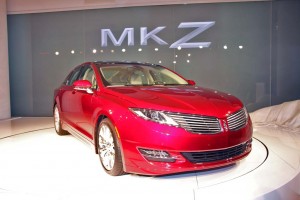Hoping to give its long-troubled luxury brand some new momentum – and much-needed economy of scale – Ford Motor Co. will launch Lincoln into the Chinese market in 2014.
The announcement – which confirms a report on TheDetroitBureau.com earlier this month – will come as a critical step for Lincoln, once one of the most powerful luxury nameplates. Even though the century-old Lincoln has never been sold in China, Ford research suggests it has significant potential in what is rapidly coming to rival the U.S. as the world’s largest high-line automotive market.
“Lincoln’s introduction to China represents a significant step forward in Ford’s aggressive growth strategy for the country,” Dave Schoch, Chairman and CEO of Ford Motor China, said during an event at a converted temple in Beijing.
The decision to bring Lincoln to China was revealed following groundbreaking of Ford’s fifth assembly plant in China and its third in the city of Chongqing.
Ford was a relative latecomer to the booming Asian nation – now the world’s largest automotive market – and has been racing to catch up to key rivals General Motors and Volkswagen AG, the two dominant manufacturers in China.
When the newest plant comes online it will help Ford double its Chinese capacity to 1.2 million vehicles annually. To support that goal, the Detroit-based maker plans to 15 new vehicles, along with 20 new powertrains, by 2015.
“This is the perfect time, with the vehicles that we have here,” to launch Lincoln into China, suggested Ford CEO Alan Mulally during the evening event.
The announcement comes just as Lincoln is about to begin what some analysts have described as a make-it-or-break-it product assault in its home market. The luxury marque aims to reverse years of declining sales and market share with the upcoming launch of the 2013 Lincoln MKZ. The smallest model in the line-up, which will be priced at $35,925, undergoes a complete transformation, with a new platform, a markedly different design, new powertrains and an assortment of additional high-end features.
One of the more distinctive features of the 2013 MKZ will be its all-glass retractable roof. But even the sedan’s signature “face” is being transformed, Lincoln designer Max Woolf giving the new model a new horizontal grille influenced, he says, by the outstretched wings of an eagle, rather than the brand’s decades-old waterfall grille.
(For more on Lincoln’s product plans, Click Here.)
Ensuring a comeback for Lincoln has become increasingly important in recent years. A decade ago, Ford all but abandoned the marque to focus on a portfolio of European brands it had acquired, including Aston Martin, Jaguar, Land Rover and Volvo. But after signing on with Ford six years ago, CEO Mulally decided to focus on the core “blue oval” brand and began selling off those foreign marques. Mulally also shuttered the ailing Mercury. Now he has to either pump some life back into Lincoln or shut it down, as well, analysts warn.
Founded in 1915, Lincoln once rivaled Cadillac for dominance in the U.S., long the world’s largest luxury car market. But both brands have slipped behind their European and Asian rivals in recent years. Complicating matters, both Lincoln and Cadillac have had little luck expanding out of the U.S. Lower volumes make it more difficult – and expensive – to stay competitive with the likes of Mercedes-Benz, BMW and Lexus.
After a series of false starts, Cadillac is now pressing to expand abroad. Its own new base model, the ATS, will play a critical role in that effort, though the maker also has grand ambitions for several “flagship” models now under development.
(For more on Cadillac’s plans, Click Here.)
During the Beijing Motor Show, earlier this year, General Motors Chairman and CEO Dan Akerson announced Cadillac would begin producing several key models in China. That move will help the brand sidestep hefty duties on auto imports – which Chinese officials recently increased as part of a trade dispute with the United States.
For now, at least, Lincoln plans to import its products, which could put it at a competitive disadvantage, though several sources hinted that the maker could shift production to China, as well, if it sees strong enough demand.
There’s no question China is hungry for luxury products. They now make up about 6% of the market there – half the share such high-line models command in the States – but Ford global marketing chief Jim Farley said he expects China’s luxury car segment to reach a 10% share by decade’s end.
For the moment, BMW, Mercedes and VW’s Audi command 80% of the market. But other players hope to chip away at that dominance. Surprisingly, while Lincoln has never competed in China, globally savvy consumers are well aware of the brand, according to extensive research the brand has conducted, Lincoln marketing executive C.J. O’donnell told TheDetroitBureau.com.
For his part, Farley suggested the brand will attempt to “distinguish itself (in China) by providing more individual and personalized motor cars, and a more personal and crafted experience to match.”
Whether it can crack the code for the fast-growing Chinese market remains to be seen, but the results could prove critical if Lincoln hopes to gain a foothold in other parts of the world. Indeed, its success – or failure – there could determine the Ford luxury brand’s long-term viability.


